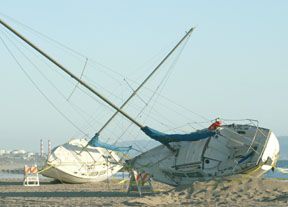
Insurance: There’s nothing fun about it. But for most boat owners, a conventional boat insurance policy is the most sensible way to safeguard their boat, and it often is a requirement of lending institutions and marinas. It is a tangled maze of deductibles and premiums—based on an extensive set of variables that include past sailing experience, boat age and condition, location, and intended sailing grounds—as well as liability and medical coverage. To get a firm grasp on the topic, PS sought quotes from numerous marine insurance agencies around the nation using a sample boat. Last month, we reported our findings in Florida, the Great Lakes, and New England. This month, we compare values, premiums, and customer service in Southern California and the Pacific Northwest. Our West Coast search reinforced our observation that from region to region, there is a wide variation in policy and level of service among insurers. For example, BoatU.S., which was our top pick last month, fell short of our expectations for coverage along the West Coast.
Our Scenario
The PS sample boat was a 1994 Catalina 36 Mk II, a model that was introduced that same year. The 1995 version of the boat sold for $97,000. The 2005 listing for a 1994 model (according to BUC) is $58,200 to $63,900.
PS solicited quotes for this boat from different companies operating in the Pacific Northwest and Southern California. We didn’t reveal to them that these quotes would be used for comparative purposes in an article. We sought to insure the boat for $80,000 actual cash value, presuming that the electronics and additional equipment on board increased the boat’s value. As we noted last month, actual cash value policies pay for replacement costs minus depreciation at the time of the loss. In a total loss, used boat pricing guides and other resources are used to determine the approximate market value of your boat. A partial loss is settled by taking the total cost of the repair minus a percentage for depreciation.
Agreed amount value policies are when the owner and the insurer agree on the amount the owner will be paid in the event of a total loss. These policies also replace old items with new in the event of a partial loss without any deduction for depreciation. Most agreed amount value policies require actual cash value on certain damaged property such as sails, protective covers, batteries, dinghies, and outboards.
To each agent, PS stipulated a $1,600 deductible, or 2 percent of the hull value, and $2,500 for personal effects; $5,000 medical coverage; and $100,000 liability coverage. The “owner” had 20 years of sailing experience, but didn’t hold a captain’s license or any certificate from a sailing or boat handling program. The boat included an inboard, four-cylinder diesel engine; original sails in reasonable condition; a float-operated bilge pump; manual fire extinguishers, but no CO detectors or other fume detectors. The electronics were described as “basic,” and we said we didn’t need coverage for the dinghy or its outboard.
We claimed that the boat stays in the water and is used year-round. We also claimed to have purchased the boat in 2003, and said we had not yet insured it. We had never filed claims on boats we’d owned before—most recently a Cal 25 we’d had for 10 years.
Southern California
PS told companies that our boat was located in Ventura, Calif. We sent Blue Water Insurance, which has an office in San Diego, an e-mail query and heard back within two days. Blue Water Insurance would place the coverage with Bankers Insurance Co., a licensed U.S. underwriter with an A rating from Demotech rating service.
The quote we received from Blue Water was accompanied by a number of conditions. It is important to be aware of these in advance. These included absentee owner stipulations—if the owner is not present for a period of 20 consecutive days, the boat is considered laid-up and the underwriter must approve the marina and caretaker arrangements. If the boat is laid up, either on the hard or in a slip, all sails, dodger, and biminis must be removed and cannot be stowed on deck. In the yard, jack stand type and setup, and other specific requirements apply. Also, a recent out-of-the-water survey would be required, and steel-hull boats more than 10 years old would need ultrasounding.
The navigation limit accompanying this quote stretched from Queen Charlotte Strait, Canada (excluding the west coast of Vancouver Island), to Rio Santo Tomas, Baja, Mexico, no more than 75 miles offshore. The quote also included $3,000 for personal effects ($500 more than we specified), and a $10,000 uninsured boaters’ limit. The total annual premium would be $913, discounted to $874 if paid by check.
We received a quote from National Marine Underwriters Inc. five days after our initial e-mail contact. The quote specified the insurance carrier as American Family Home Insurance Co. National Marine Underwriters rejected our $100,000 liability figure and prescribed $300,000. It also rejected the $2,500 personal effects coverage request in favor of $500 in coverage. Likewise, the medical coverage we requested was reduced to $2,500. Scrutinizing the fine print, we learned that additional coverage for both medical and personal effects could be purchased for $10 per $500 more in coverage each. The information also stated that medical payment coverage could not exceed $5,000, and personal effects coverage couldn’t exceed $10,000. National Marine Underwriters included emergency towing assistance at no additional cost, and there were no lay-up restrictions.
The policy from National Marine also offered uninsured watercraft coverage, and pollution or contamination coverage. Both a catastrophe deductible of $1,600 and a theft deductible of $1,600 were included. We were told that a survey would be required to obtain the policy, and this quote would be good for only 30 days. The total premium was $915.
PS filed an online request with Offshore Risk Management on two separate occasions, 10 days apart. We followed up with a third e-mail a week later, but didn’t get a response for several weeks, when the company offered three quotes.
The first was through American Family Home Insurance Co. Boat and equipment were covered for $80,000 with an unspecified deductible, and $100,000 liability coverage that included pollution liability and uninsured boaters’ coverage. That quote met our requirements for medical payments and personal effects, with a $50 deductible applied. Additional coverage in these areas was also available. Towing services and emergency coverage would carry a deductible of $100 for each incident. The navigation limits were set to coastal California out to 50 nautical miles. This policy offered three options regarding premiums. At 1 percent of hull value ($800) deductible, the premium would be $1,010. At 3 percent of hull value (a $2,400 deductible), the premium would be $889. At 5 percent of hull value (a $4,000 deductible), it would be $808.
ORM also returned a quote using St. Paul Fire and Marine Insurance as the underwriter. Hull and machinery were covered for $80,000 with an $800 deductible; liability was set at $100,000; and medical payments would be covered up to $5,000. Uninsured boaters’ coverage was $100,000, while personal property would be covered up to $750 with a $50 deductible applied. Pollution liability would be covered at $500,000. The navigation limits were not defined in the quote, and the premium was set at $760.
The third quote would be written with TL Dallas Yacht Facility, and this included hull and machinery covered at $80,000 with a $1,600 deductible. Liability coverage would be $100,000 with a separate $500 deductible. Medical coverage would be $5,000 with a $100 deductible. Uninsured boaters’ were covered for $25,000 with a separate $500 deductible. And personal property coverage would be $2,500 with a $250 deductible. The navigation limits were not spelled out in this quote, and the premium was set at $1,525.
BoatU.S. responded to a quote request the following day. The quote covered only liability ($187 premium; no deductible) because our boat had not been previously insured and did not have a recent out-of-water survey. BoatU.S. would, however, cover the boat with an agreed hull value that would meet our specified parameters, but the insurer would not specify a premium without the survey. To get BoatU.S. insurance, owners must be members of BoatU.S.; a membership costs $19 annually.
PS attempted to contact International Marine Insurance Services (IMIS) on two separate dates to request a quote. We followed those with an e-mail three days later and made another attempt a week later. An agent called us back with questions, and the following week the company provided a quote based on the information we’d initially given, without the benefit of our subsequent answers. Using the New Hampshire Insurance Co. as the underwriter, IMIS offered $300,000 liability coverage, $5,000 medical, and $2,500 in personal effects. Also included in this premium was $500 in towing coverage, $100,000 for uninsured boater liability, and $300,000 for fuel spill liability. The premium for this quote was $685.
Pacific Northwest
PS submitted an online quote request to Blue Water Insurance for this location, and the company responded the following day with two insurance options. Both quotes approximately matched our original parameters, save for an increase in personal effects coverage to $3,000. The two policies differed regarding the type of sailing we anticipated.
The first limited coverage to the Queen Charlotte Strait, Canada, south to Rio Tomas in Baja, Mexico, not more than 75 miles offshore, and carried a premium of $863 (discounted to $826 if paid by check).
The second option limited the sailing to within the waters of the Puget Sound and tributaries, the Straits of Juan de Fuca, and the inside waters of British Columbia, not north of 51° N or west of Cape Scott or Cape Flattery. That premium was $812, with a discount for paying by check set at $777.
National Marine Underwriters states on its website that if its agents can’t get an immediate quote, they’ll get back to you in one business day. We received the quote six days after our request, and it altered our parameters as follows: the deductible, $800, or 1 percent of hull value; liability, $300,000; personal effects coverage, $500; and medical coverage, $2,500. Upgrades were available at $10 per $500 in coverage. The deductible for theft and catastrophe would be $800. The navigation limits were set at 20 miles offshore from the U.S. The total premium would be $1,029.
A week later, we requested a re-quote, inadvertently letting the $300,000 liability stand, and received a new premium of $1,052. An amended quote came the next day: $976.
Offshore Risk Management responded promptly to our request for a quote, responding in one day. This company’s policy, which would include coverage through American Family Home Insurance Co., covered liability at $100,000, including pollution liability and uninsured boaters’ coverage. Medical coverage would be $2,500 with personal effects covered to $500, though higher amounts were available. A waiver of depreciation ($168) was also available, but not included in the final tally. Offshore Risk Management offered 2 percent, 3 percent, and 5 percent hull-value deductibles ($1,600, $2,400, and $4,000). Premiums based on the hull deductibles were $875, $942, and $1,043. A survey wasn’t necessary, but photographs of the boat were requested. The company specified navigation limits as the coastal waters of the Pacific Northwest. But we learned that extended cruising coverage was an option, pending approval, for an additional $500 charge, with applicable restrictions and underwriter approval.
A week later, ORM sent another quote, this time using Markel Insurance Co. as the underwriter. The quote included a 2 percent deductible as requested, offering $300,000 in liability, $10,000 in medical coverage, $300,000 uninsured boaters’ coverage, $2,500 in personal property, $500,000 in pollution, $750 for towing and emergency expenses, and $100 for rental reimbursements due to claims. All of this for a premium of $887.
We submitted an online quote request to BoatU.S., but didn’t receive a response even though we followed up a week later.
A faxed request to IMIS went unanswered, so we submitted a request online a week later. Five days after that, we received our quote. IMIS, using the New Hampshire Insurance Co., offered $100,000 in liability and a 2 percent deductible ($1,600) on the agreed hull value of $80,000 for $547. The quote included $5,000 for medical, $2,500 for personal effects, $500 for towing, $100,000 for uninsured boaters’ coverage, and $100,000 for fuel-spill liability. This was the most economical quote we received.
Conclusions
PS found many companies weren’t concerned with prompt responses. However, agents assured us that a week’s turn-around is standard.
Our attempt to keep the quote consistent for comparison went awry when companies’ policy limits varied from those requested.
Based on the West Coast review, IMIS offers the most economical coverage and more flexible plans than its competitors. The company’s timeliness was lacking, but a persistent boat owner looking for a quote would benefit with up-front policy detailing, lower premiums, and fewer restrictions.
Although Offshore Risk Management’s customer service was hit-or-miss, the coverage met the majority of our requests and included coverage for pollution and towing. ORM’s premiums were on the low end of those in the review.
Blue Water Insurance offered timely quotes, but its West Coast coverage involved too many restrictions. National Marine Underwriters’ premiums were consistently high.
BoatU.S.—although it came out on top in last month’s marine insurance breakdown—faltered on the West Coast. Neither the coverage offered nor the timeliness of the quote was adequate. We also don’t like its reluctance to insure older boats and boats not previously insured.
Marine insurance is far from being an apples-to-apples matchup. So in order to find the best insurance to fit your needs, be prepared to do a little research and shopping around—and be sure to have some Tylenol handy.
Also With This Article
“Marine Insurance: Southern California”
“Marine Insurance: Pacific Northwest”
Contacts
• Blue Water Insurance, 800/866-8906, www.bluewaterins.com
• BoatU.S., 800/283-2883, www.boatus.com
• National Marine Underwriters Inc., 800/262-8467, www.nmu.com
• Offshore Risk Management, 800/773-0105, www.offshorerisk.com
• International Marine Insurance Services, 410/827-3757, www.imiscorp.net



































